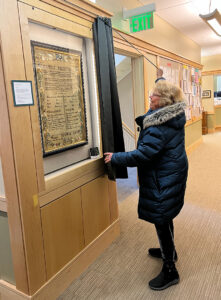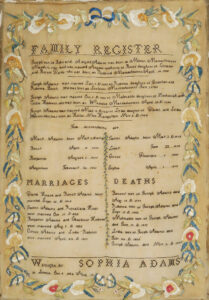The Lincoln Town Hall is home to plenty of historically valuable documents — but until now, few if any of them were hand-stitched.
The Lincoln Town Archives and Lincoln Historical Society recently put on display a sampler created in 1826 by 13-year-old Sophia Adams. The artifact is in a climate-controlled case just down the hall from the Town Clerk’s office, and former Town Clerk Susan Brooks (one of those who was involved in the project) pulled the string at the official unveiling.
Samplers are pieces of embroidery worked in various types of stitching that were commonly created by girls and young women as a demonstration of their skills and perseverance. Many samplers are family registers, recording the births, marriages, and deaths in the life of a family. The Adams sampler was donated to the town in 2017 by Cynthia Williams, whose husband was a great-grandson of the young seamstress.
Sophia lived on Route 2A in Lincoln (the Battle Road) on what was then known as Foster’s farm, very close to the Paul Revere capture site. There were two houses on the property: one where the Smiths lived that’s still standing across from the end of Bedford Road; the other was a rental that became the Foster-Winship-Adams residence where Sophia worked on her sampler, according to research done by Lincoln historians.
The names and dates give insight into the often-too-short lives of people in that era. It begins with the 1759 birth of Joseph Adams, a distant cousin of President John Adams, and lists his first marriage to Betsey Davis, who died at age 34, less than two weeks after her youngest son’s birth. Having five children to raise, Joseph married Rebecca Patch just over two years later. This was short-lived as Rebecca died within nine months. The sampler records that he then married Mehitable Hildreth, who bore him three children, the youngest being Sophia.
Mehitable died when Sophia was six, and Joseph was married for the last time in 1821 to Lincoln widow Lydia Winship (nee Wheeler), who may have taught Sophia to sew. Lydia owned the Foster property, which had been left to her on the death of her first husband, Benjamin Winship, in 1819. Winship had originally purchased the land from widow Catherine Louisa Smith, whose husband Captain William Smith was a younger brother of Abigail Adams, wife of the second President. Benjamin and Lydia Winship had only one daughter, also named Lydia, who died at age 16. All three of them have their final resting place at Meeting House Burial Ground behind Bemis Hall.
At 31.5 inches by 21.5 inches, the sampler is especially significant because it is quite large compared to other samplers of its time. Sophia’s silk stitching (which includes cross, satin, split stem and French knot stitches) was embroidered onto a particularly fine plain weave fabric with a plain weave cotton backing. Due to the fineness of the backing, unlike the coarser linen backing used on many samplers, this would have been especially challenging for a 13-year-old to stitch.
“I’m rather amazed with the care and protection of this rather important textile, and I commend all of you for doing that. For me, it was a very unique piece,” said Deidre Windsor, who carried out the painstaking preservation. Among her other projects: restoring an 18th-century embroidered silk kerchief owned by the Old State House and Old South Meeting House that was damaged in a water leak.
When she first encountered the sampler, which had been hanging on the wall of the Williams home, “it was quite gray” from soil and dust, had some insect holes, and was attached to an acidic backing, Windsor said. The nearly translucent fabric was too delicate to withstand water, so the cleaning was done using a special type of vacuum cleaner and gentle sponging. Because the fabric was so thin, it was hard to keep in place while Sophia was sewing, “so her lines have a bit of a wiggle.”
Lincoln voters approved a Community Preservation Act grant of $17,675 in 2017 to restore Sophia’s sampler and prepare it for public display at Town Offices, including framing it with museum-quality UV filtering acrylic and building an archival box set into the wall with four preconditioned packets of silica gel to keep the air inside at 45% humidity.


I can’t wait to see it.
Good work by everyone who made this happen.